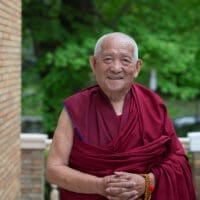Overview
In order to understand Buddhist accounts of the person, one must first identify the object of negation-the thing whose existence is to be refuted. That is the atman, or the unchanging, partless core self that is distinct from mind and body, and is what is reborn. At the time of the Buddha, the orthodox position in India was that every person has such an atman. The Buddhist doctrine of no self-anātman-rejects that view. The Buddha argued that nothing is permanent or has an essence, and that persons, like everything else, are impermanent, constantly changing, partite, and exist only in dependence on causes and conditions, their parts and on mental imputation. This rejects the orthodox self, but does not reject the conventional, ordinary empirical existence of persons as dependently originated phenomena. Different Buddhist tenet systems have different ways of identifying the person. The Vaibhasika assert that the mind and body are the self. The Yogācāra assert instead that the person is the fundamental mind. Mādhyamikas argue that everything is impermanent, dependent, ultimately empty of true existence and only conventionally real. Prasangika Mādhyamikas say that while the body and mind are not the self, they are the basis for the designation, “self.” The conventional self on this view is imputed on this basis. The self on this view is an impermanent phenomenon but is neither material form nor consciousness.
- Dialogue 3019 sessions
- December 16, 2015Sera Monastery, Bylakuppe, India


